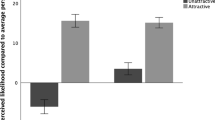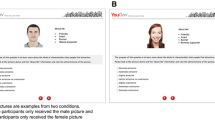Abstract
Despite people’s universal interest in the pursuit of physical attractiveness, little is known about the behavioral consequences of individuals’ self-perceived physical attractiveness. Across four studies, we find that a boost in individuals’ self-perceived attractiveness increases public self-consciousness and thus heightens their motivation for impression management, which in turn increases prosocial behavior. Furthermore, we identify the salience of privateness as an important moderator. The effect of self-perceived attractiveness on prosocial behavior is disrupted when the privateness of prosocial behavior is made salient. This research thus provides evidence for the causal link between self-perceived physical attractiveness and prosocial behavior.



Similar content being viewed by others
Data Availability
We have deposited the data here:https://osf.io/bqnu6/
References
Aharon, I., Etcoff, N., Ariely, D., Chabris, C. F., O’Connor, E., & Breiter, H. C. (2001). Beautiful faces have variable reward value: fMRI and behavioral evidence. Neuron, 32(3), 537–551.
Akimoto, S. A., Sanbonmatsu, D. M., & Ho, E. A. (2000). Manipulating personal salience: The effects of performance expectations on physical positioning. Personality and Social Psychology Bulletin, 26(7), 755–761.
Baumeister, R. F., Tice, D. M., & Hutton, D. G. (1989). Self-presentational motivations and personality differences in self-esteem. Journal of Personality, 57(3), 547–579.
Belmi, P., & Neale, M. (2014). Mirror, mirror on the wall, who’s the fairest of them all? Thinking that one is attractive increases the tendency to support inequality. Organizational Behavior and Human Decision Processes, 124(2), 133–149.
Christou, P., Farmaki, A., Saveriades, A., & Georgiou, M. (2020). Travel selfies on social networks, narcissism and the “attraction-shading effect.” Journal of Hospitality and Tourism Management, 43, 289–293.
Costello, J. P., & Malkoc, S. A. (2022). Why are donors more generous with time than money? The role of perceived control over donations on charitable giving. Journal of Consumer Research, 49(4), 678–696.
Dion, K., Berscheid, E., & Walster, E. (1972). What is beautiful is good. Journal of Personality and Social Psychology, 24(3), 285–290.
Dubois, D., Bonezzi, A., & De Angelis, M. (2016). Sharing with friends versus strangers: How interpersonal closeness influences word-of-mouth valence. Journal of Marketing Research, 53(5), 712–727.
Expert market research. (2024). Global Cosmetics Market Size, Analysis, Trends, Forecast: By Product: Hair Care, Skin and Sun Care, Makeup and Color Cosmetics, Fragrances and Deodorants, Others; By Gender: Men, Women, Unisex; By Price Range: Mass, Mid-premium, Premium; By Distribution Channel; Regional Analysis; Competitive Landscape; 2024-2032. https://www.expertmarketresearch.com/reports/cosmetics-market. Accessed 25 Apr 2024.
Feingold, A. (1992). Good-looking people are not what we think. Psychological Bulletin, 111(2), 304–341.
Fenigstein, A., Scheier, M. F., & Buss, A. H. (1975). Public and private self-consciousness: Assessment and theory. Journal of Consulting and Clinical Psychology, 43(4), 522–527.
Gill, R. (2021). Changing the perfect picture: Smartphones, social media and appearance pressures. https://www.city.ac.uk/__data/assets/pdf_file/0005/597209/Parliament-Report-web.pdf. Accessed 25 Apr 2024.
Han, D. E., & Laurent, S. M. (2023). Beautiful seems good, but perhaps not in every way: Linking attractiveness to moral evaluation through perceived vanity [Article]. Journal of Personality and Social Psychology, 124(2), 264–286.
Hayes, A. F. (2017). Introduction to mediation, moderation, and conditional process analysis: A regression-based approach. Guilford Publications.
Holtzman, N. S., Augustine, A. A., & Senne, A. L. (2011). Are pro-social or socially aversive people more physically symmetrical? Symmetry in relation to over 200 personality variables. Journal of Research in Personality, 45(6), 687–691.
Jia, L., Yang, X., & Jiang, Y. (2022). The pet exposure effect: Exploring the differential impact of dogs versus cats on consumer mindsets. Journal of Marketing, 86(5), 42–57.
Jiang, Z., Xu, J., Gorlin, M., & Dhar, R. (2021). Beautiful and confident: How boosting self-perceived attractiveness reduces preference uncertainty in context-dependent choices. Journal of Marketing Research, 58(5), 908–924.
Kulow, K., & Kramer, T. (2016). In pursuit of good karma: When charitable appeals to do right go wrong. Journal of Consumer Research, 43(2), 334–353.
Leary, M. R., & Kowalski, R. M. (1990). Impression management: A literature review and two-component model. Psychological Bulletin, 107(1), 34–47.
Miller, D. T., & Turnbull, W. (1986). Expectancies and interpersonal processes. Annual Review of Psychology, 37(1), 233–256.
Miller, L. C., & Cox, C. L. (1982). For appearances’ sake: Public self-consciousness and makeup use. Personality and Social Psychology Bulletin, 8(4), 748–751.
Muñoz-Reyes, J. A., Pita, M., Arjona, M., Sanchez-Pages, S., & Turiegano, E. (2014). Who is the fairest of them all? The independent effect of attractive features and self-perceived attractiveness on cooperation among women. Evolution and Human Behavior, 35(2), 118–125.
Park, J. H., Huang, S. C., Rozenkrants, B., & Kupor, D. (2021). Subjective age and the greater good. Journal of Consumer Psychology, 31(3), 429–449.
Samper, A., Yang, L. W., & Daniels, M. E. (2018). Beauty, effort, and misrepresentation: How beauty work affects judgments of moral character and consumer preferences. Journal of Consumer Research, 45(1), 126–147.
Scheier, M. F., & Carver, C. S. (1985). The self-consciousness scale: A revised version for use with general populations. Journal of Applied Social Psychology, 15(8), 687–699.
Schlenker, B. R. (1975). Self-presentation: Managing the impression of consistency when reality interferes with self-enhancement. Journal of Personality and Social Psychology, 32(6), 1030.
Schlenker, B. R., & Weigold, M. F. (1990). Self-consciousness and self-presentation: Being autonomous versus appearing autonomous. Journal of Personality and Social Psychology, 59(4), 820–828.
Simpson, B., & Willer, R. (2008). Altruism and indirect reciprocity: The interaction of person and situation in prosocial behavior. Social Psychology Quarterly, 71(1), 37–52.
Sui, J., & Liu, C. H. (2009). Can beauty be ignored? Effects of facial attractiveness on covert attention. Psychonomic Bulletin and Review, 16(2), 276–281.
Tedeschi, J. T., Schlenker, B. R., & Bonoma, T. V. (1971). Cognitive dissonance: Private ratiocination or public spectacle? American Psychologist, 26(8), 685.
Thornton, B., & Moore, S. (1993). Physical attractiveness contrast effect: Implications for self-esteem and evaluations of the social self. Personality and Social Psychology Bulletin, 19(4), 474–480.
White, K., & Peloza, J. (2009). Self-benefit versus other-benefit marketing appeals: Their effectiveness in generating charitable support. Journal of Marketing, 73(4), 109–124.
Wyer, R. S., & Xu, A. J. (2010). The role of behavioral mind-sets in goal-directed activity: Conceptual underpinnings and empirical evidence. Journal of Consumer Psychology, 20(2), 107–125.
Funding
This research was supported by the National Natural Science Foundation of China (72172131) awarded to Professor Jun Ye.
Author information
Authors and Affiliations
Corresponding author
Ethics declarations
Ethical approval
Not applicable.
Informed consent
Informed consent was obtained from all individual participants involved in the study.
Conflict of interest
The authors declare no competing interests.
Additional information
Publisher's Note
Springer Nature remains neutral with regard to jurisdictional claims in published maps and institutional affiliations.
Supplementary Information
Below is the link to the electronic supplementary material.
Rights and permissions
Springer Nature or its licensor (e.g. a society or other partner) holds exclusive rights to this article under a publishing agreement with the author(s) or other rightsholder(s); author self-archiving of the accepted manuscript version of this article is solely governed by the terms of such publishing agreement and applicable law.
About this article
Cite this article
Meng, H., Ye, J. Looking good and doing good: the effect of self-perceived attractiveness on prosocial behavior. Mark Lett (2024). https://doi.org/10.1007/s11002-024-09735-5
Accepted:
Published:
DOI: https://doi.org/10.1007/s11002-024-09735-5




